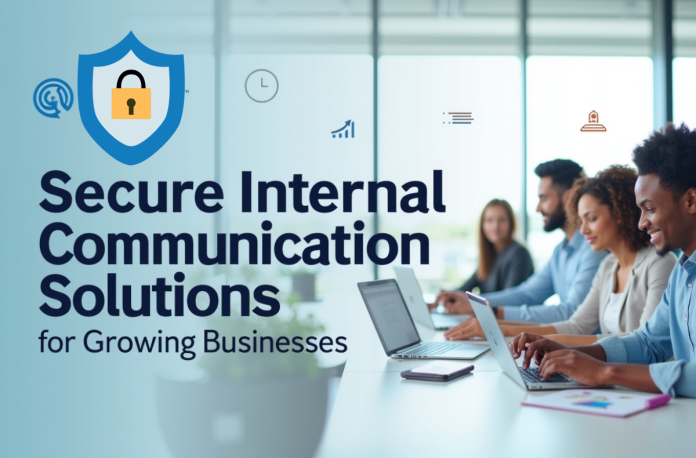In the modern digital workplace, email, instant messages, and files shared regarding work are the lifeblood of growing businesses. This river of data, from financial forecasts to clients’ files, is a highly valuable asset. But if you leave it vulnerable, it will soon be your biggest weakness. Having secure internal communication is no longer an IT issue; it’s a basic business need to protect sensitive information, achieve compliance, and operate with integrity.
Here is a clear roadmap for small and medium-sized businesses (SMBs) to not only understand the threats but also how to protect themselves with realistic and effective strategies. You’ll also know how to strengthen your defenses, select the best internal communication tools for security, and plant a culture of secure internal communications without breaking the bank or hiring an army of technical talent.
Key Takeaways
- Secure internal communication is crucial for protecting sensitive information and ensuring compliance against data breaches and human error.
- SMBs must understand the risks and implement strategies like encryption, access control, and employee training.
- Choosing the right secure internal communication tools is vital; enterprise-grade solutions provide better security than consumer-focused apps.
- Develop a formal communication compliance policy to guide employees on approved communication channels and data handling procedures.
- Stay updated on emerging trends like zero-trust architecture and post-quantum encryption to enhance internal communication security.
Table of Contents
- Understanding the Risks of Insecure Communication
- Essential Strategies for Secure Internal Communication
- Choosing the Right Secure Internal Communication Tools
- The Role of a Secure Internal Communication Compliance Policy
- Future Trends for Secure Internal Communications
- Fortify Your Business with Secure Internal Communication
- FAQs
Understanding the Risks of Insecure Communication
But before you can mount a defense, you need to know what the threats are. Digital communication is fraught with risks, and some of these can have severe consequences. Not focusing on securing internal communication leaves your company exposed to data breaches, compliance violations, and expensive mistakes made by people.
Data Breaches and Financial Implications
Cyber attackers are increasingly focused on businesses of all sizes, and internal communication channels represent a bounty of valuable insight. Data, like customer lists and financial records, can be sold illicitly on the black market; leaked intellectual property could give their competitors an unfair advantage.
| Financial Impact of a Data Breach | Average Cost |
|---|---|
| Global Average Cost | $4.45 Million |
| Lost Business Costs | $1.52 Million |
| Breach Detection & Escalation | $1.24 Million |
As the table reveals, the financial repercussions of a breach reach well beyond immediate remediation expenses. Reputation damage and loss of credibility with customers are lasting. A solid architecture for secure internal communication is therefore your first line of defense against these kinds of attacks.
Compliance Failures and Regulatory Penalties
There are many industries that have strict compliance requirements, such as GDPR, HIPAA, and SOX, which dictate how data is managed and protected by businesses. Lack of secure internal communication can also result in fines or legal proceedings. For example, financial companies in the U.S. have been hit with billions of dollars in fines for not overseeing business communications made on unapproved apps such as WhatsApp.
Human Error and Communication-Related Breaches
As *much as I am scared of the outside threats, the employee negligence is what I find is the weakest link. Human errors are among the top causes of data breaches, according to the Ponemon Institute. Common mistakes include:
- Accidentally sharing sensitive files with the wrong person.
- Choosing poor passwords for your communication tools.
- Logging into business accounts on unprotected public Wi-Fi.
- Being lured in by social engineering, where employees are duped into giving away secrets.
For lack of a solid fence for secure communication within, such little mistakes could snowball into substantive security disasters.

Essential Strategies for Secure Internal Communication
Securing your business is a matter of technology, policy, and training. Here are the critical tactics that every SMB can take to protect itself from internal communications risks.
Encryption: The Technical Foundation
Encryption jumbles your data into an unreadable format so it’s worthless to anyone who intercepts it without permission. End-to-end encryption (E2EE) is the best kind, meaning only the sender and an intended receiver can decode a message. This security is needed in all secure communication techniques, and the one presented here is no exception. When assessing tools, ensure they provide E2EE for data in transit and at rest.
Access Control: Implementing Least Privilege
The concept of “least privilege” means that workers should only be granted access to the data and the systems they need to do their job. This limits the scope of any exposure from an account compromise. Key access control measures include:
- MFA (Multifactor Authentication): Users must enter two or more forms of verification to sign in. MFA, according to a Microsoft study, will stop more than 99% of account compromise attacks.
- Role-Based Access Control (RBAC): Uses role assignments to set permissions based on an employee’s position, limiting access to your most sensitive channels and data.
Employee Training: Reducing Human Error
An aware team is the best defense against many cyber threats. Frequent training creates a security-minded environment in which employees are directly involved in safeguarding business information. Good training programmes should be ongoing and comprise:
- Mimicked phishing exercises that empower employees to identify actual threats outside of the office.
- Strong processes around how sensitive information is handled and what communication tools are used.
- Guidelines for timely reporting of suspicious activity.
Monitoring and Archiving: Creating a Defensible Record
For most businesses, it is a need not just to monitor but also to archive their communications. These practices came at a cost, such as providing verifiable records to appease auditors or a subpoena. When you deploy monitoring, being candid with employees about what’s being tracked can be important to preserve trust. A secure platform will have built-in audit trails, which keep a record of who accessed what and when.
Regular Audits and Updates: Keeping Defenses Current
The security climate changes every day. Regular security audits and prompt updates are needed to safeguard against emerging vulnerability points. Establish a regular pattern of penetration testing and processing reviews to detect and fix the vulnerabilities in your secure internal communication system before they become opportunities for attackers.

Choosing the Right Secure Internal Communication Tools
The tools you use are central to your security posture. While many platforms offer convenience, not all are built with enterprise-grade security in mind.
Consumer-Focused vs. Enterprise-Grade Solutions
Consumer-friendly apps such as WhatsApp and Telegram are common avenues for personal use, but they typically lack the security and compliance offerings demanded by businesses. These tools might not provide sufficient data encryption, access control, or the ability to archive, potentially leaving your business vulnerable. In 2019, for instance, a breach that let spyware be installed on phones through WhatsApp underscored the risk in using such tools for business.
Enterprise-scale platforms, on the other hand, are built for secure communications inside your organization. They are providing functionality designed for the business and compliance needs.
| Platform | Focus | Key Security Differences |
|---|---|---|
| Email/Standard Messaging | General Communication | Often lacks E2EE by default; limited access controls and audit trails. |
| Slack/Microsoft Teams | Collaboration | Offer some enterprise security features, but advanced compliance and data protection often require higher-tier plans. Security can be complex to configure correctly. |
| Signal/Wire | Secure Messaging | Strong E2EE but may lack the centralized management, compliance, and archiving features needed for enterprise use. |
| LeapXpert/Karbon | Enterprise Communication | Built specifically for secure internal communication with integrated compliance, advanced encryption, governance controls, and comprehensive audit trails. |
Features to Look For in Secure Internal Communication Software
When considering options, favor platforms that provide:
- Encryption: End-to-end for all messages, files, and calls.
- Enhanced Access Controls: MFA and RBAC, for example.
- Detailed Audit Trails: To monitor all user and admin actions.
- Data Loss Prevention (DLP): To eliminate unauthorized sharing of important data.
- Unified Management: To manage policies and users from a single central dashboard.
The Role of a Secure Internal Communication Compliance Policy
Having a Formal Communication Compliance Policy. Involvement, consistency, and clarity are part of the communication process. It can be used as a reference for employees, minimizes uncertainties, and also reduces the usage of unauthorized tools (shadow IT).
Your policy should clearly define:
- Approved and prohibited communication channels.
- Recommendations for dealing with various kinds of sensitive information.
- Procedures for reporting security incidents.
- Consequences for non-compliance.
This policy is only effective if it is consistently upheld, so training and compliance monitoring will be crucial in its implementation for creating a culture of secure internal communication.

Future Trends for Secure Internal Communications
Secure internal communication continues to be restructured to adapt to emerging threats. As is the case with technology, business needs to respond.
Key trends to watch include:
- Zero Trust Architecture: It works on the “never trust, always verify” concept. Each user and device must be authenticated and authorized to access the data, whether they reside inside or outside the corporate network.
- Post-Quantum Encryption: Quantum computers will one day break today’s encryption methods. Some forward-thinking companies are now investigating post-quantum cryptography to protect their data well into the future.
- Messaging Layer Security (MLS): This is the first new standard in the series that affords scalable, confidential group messaging, perfect for big entities.
Adjusting to these trends will be essential in order to uphold sustainable internal communications security over time, specifically amid the new normal of remote and hybrid work this decade.
Fortify Your Business with Secure Internal Communication
In an age of rising digital threats and regulatory pressures, taking a loose approach toward secure internal communication is a risk no organization can afford. By knowing the risks, having strong security measures in place, and selecting the appropriate tools, you can leave no stone unturned to protect your business’s most valuable treasures.
Developing a robust security fortress is an iterative process, based on technology, solid policies, and good training. If anything, begin today by looking at what you are doing and how you can do it better. Crossing the bridge or preparing your business to secure internal communication is one of the best things you can do for your company.
FAQs
Internal secure communication is the confidentiality of all files, messages, and calls sent within an organisation. It requires secure messaging, increased oversight of information sharing, and policies to prevent unauthorized release, maintain compliance, and foster confidence.
Businesses also want it to safeguard sensitive information financial reports, customer names, or intellectual property, and to keep from running afoul of regulations like GDPR or HIPAA, post-breach costs, and the trust of employees and customers.
The most significant risks include loss of data through cyber-attacks, non-compliance fines, and human error, where staff may be duped into a phishing scam or unwittingly reveal sensitive information. It also introduces potential (and very real) vulnerabilities by relying on unapproved, consumer-grade messaging apps.
Using unapproved or consumer-grade apps for work can expose a company to substantial risks, such as weak encryption and the absence of compliance features like archiving, and cause data to leak. Regulators have fined companies heavily for doing business on untracked channels.
Good training includes frequent, hands-on experiences like simulated phishing to show employees how actual threats present themselves. It also needs to explicitly state company policies and standard operating procedures for managing sensitive data and reporting incidents.
Find one that is designed specifically for business, with end-to-end encryption, MFA, and role-based access controls and robust audit trails. Verify that it complies with industry-specific regulations and can be integrated within the existing IT function in your company.










